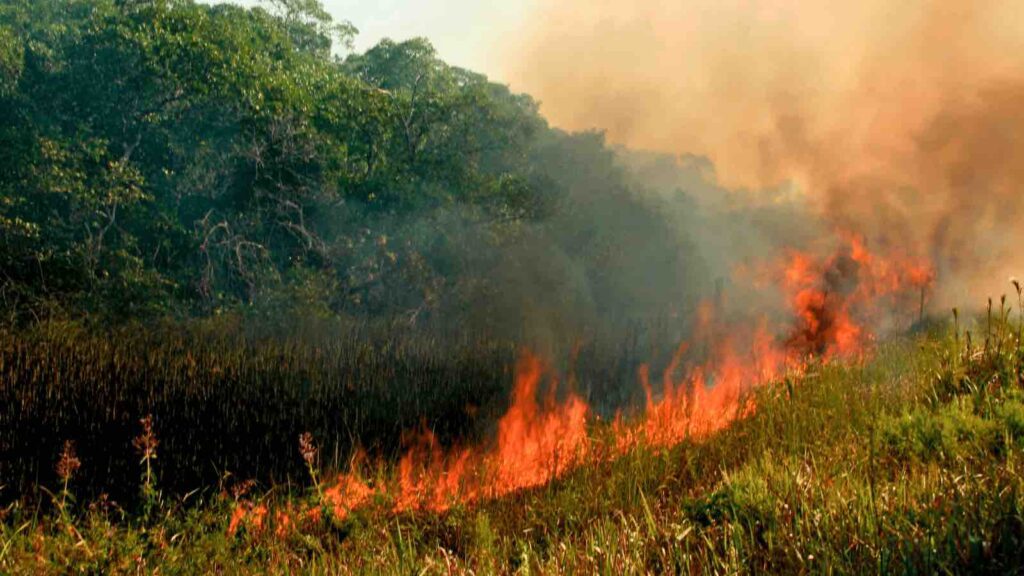Earlier in October, similar scenes of devastation had already haunted the neighborhoods of Tampines and Pasir Ris.
The tranquil night of October 15, 2023, was disrupted by an eerie orange glow at Lim Chu Kang Chinese Cemetery in Singapore. Flames raced across an expanse equal to a football field, marking the third significant vegetation fire for the month. As the city-state grappled with this recurrence, many found themselves wondering: why here, and why now?
RELEVANT SUSTAINABLE GOALS


A Fire in The Dark
Social media became the pulse of the crisis. On TikTok, user @abgzack591’s haunting visuals of the Lim Chu Kang conflagration showcased the magnitude of the event. The time stamp indicated it was around 10pm, and multiple areas appeared to be simultaneously under siege by the flames. The glow reflected off a police vehicle, a silent sentinel amidst the chaos. In another snippet from @mxhdnxh, billows of smoke painted a scene that seemed almost surreal against the serene night. The Singapore Civil Defence Force (SCDF) appeared as knights in fire-resistant armor, challenging the flames with unwavering valor.
@abgzack591 JUST NOW TAICHI Chinese cemetery 10pm+ **take note Google LIM CHU KANG FIRE... It's common that place to catch fire..Why?? PLS Google #fyp ♬ original sound - AbgZack
The SCDF confirmed they were alerted to the crisis near Chinese Cemetery Path 13 around 7:25pm. With swift precision, they utilized two hose reels to subdue the fiery monster that spread its reach across the cemetery grounds. Miraculously, amid such a fierce onslaught, there were no casualties. Yet, the underlying cause remained an enigma, with an investigation underway.
Hot And Dry Weather Due to El Niño
The tapestry of fires woven across Singapore in October paints a broader picture. Just days apart, Pasir Ris and Tampines were struck by similar conflagrations. The National Parks Board (NParks) had promptly collaborated with the SCDF to fathom the roots of these incidents. A preventive measure was clear: reduce vegetation on trails and augment the frequency of park inspections during dry spells.
Yet, therein lies a paradox. Fires in public spaces are not anomalies in themselves. Often, they emerge from seemingly innocuous acts: discarded cigarette butts, unattended incense. But the frequency and magnitude of recent blazes hint at a more pervasive culprit: nature itself.
Singapore currently endures the grip of El Niño, a climatic titan with a profound influence over the tropical Pacific Ocean. With this phenomenon come drier and hotter conditions—a natural tinderbox. El Niño’s looming presence was pronounced by the Meteorological Service Singapore (MSS) on August 11, 2023, predicting its strengthening grasp till the beginning of 2024.
It’s a haunting echo from the past. In March 2019, Lim Chu Kang became the epicenter of another massive blaze, necessitating the deployment of 52 valiant firefighters who battled the elements throughout the night. As one reflects on this, the recent fires seem less like isolated incidents and more a stern reminder of nature’s cyclical patterns.
However, the power to influence this cycle, at least marginally, lies with the populace. NParks’ clarion call is simple: vigilance and responsibility. By refraining from smoking or littering in green expanses, and ensuring responsible disposal of flammable items, every individual can play a role in forestalling such catastrophes.
Singapore’s legacy lies in its ability to transform challenges into opportunities. As the city-state stands at the nexus of urban advancement and environmental balance, its response to this crisis might very well set the tone for urban centers globally. In this battle with the flames, the Lion City doesn’t just fight for itself, but for a world seeking sustainable urban blueprints for the future.
Lead image is the vegetation fire in Bahia courtesy of Joe Souza from Getty Images Signatures
You may also be interested in :
Smoke Signals From Palangkaraya : A City’s Cry For Help Amid Unyielding Fires


